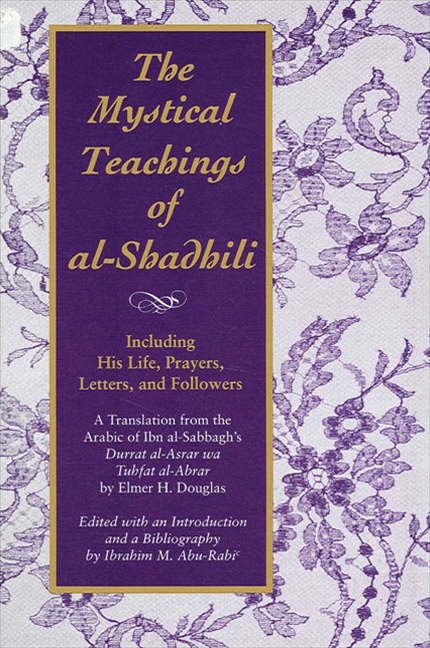Book | Ibn Sabbagh: Durrat al-asrar – درة الأسرار وتحفة الأبرار لابن الصباغ
﷽
 Arabic: Maktaba Misriyya lil-Turath
Arabic: Maktaba Misriyya lil-Turath  English transl. Elmer H. Douglas as "The Mystical Teachings of al-Shadhili"
English transl. Elmer H. Douglas as "The Mystical Teachings of al-Shadhili" About the Author
The author, Ibn al-Sabbagh, was writing a little more than six decades after the death of Imam Abul Hasan al-Shadhili. He received his information from the master’s disciples in Tunisia and Egypt, and from their companions and disciples. In his endeavor to record narrations of sayings and supplications of Imam Abul Hasan, he made efforts to meet anyone who might be acquainted with them. He says:
“Some I received directly in Tunis from the righteous Shaykh Abu ale`Azai’m Abu Madi ibn Sultan, pupil and servant of Abu al-Hasan. Some of them I secured in the eastern lands, of Abu ‘Abd Allah Muhammad, called Sharaf al-Din, son of Yaqut al-Habashi. Some of them I received from still other devotees of the Sufi Path of our shaykh and from companions of his companions from among the people of the East and the West, until – ”
there was brought together in my possession material the hearing of which is a source of delight, and the collection of which is something rare.
Chapters
He continues: “I have divided it into five chapters. Contents: [1] [2] [3] [4] [5]
I have entitled the work Durrat al-asrar wa tuhfat al-abrar [The Pearl of Mysteries and the Treasure of the Righteous], concerning the states and stations, extraordinary powers and divine gifts, supplications and devotional recitations that have been attributed to our master, the shaykh, the saint, the gnostic, the one with true knowledge, the trustworthy, the Qutb, the Ghawth, Abu al-Hasan ‘Ali, in order that its appellation may be in accord with the work indicated by the name and conformable to its significance.
From God, I hope for approval and the attainment of the object of my expectations, because He is the preserver from error in narration and the One who brings felicity by His help in lucidity of expression. There is no Lord at all other then He, and no good except His. ”
Preface
Editor’s Introduction
Author’s Introduction to the Pearl of Mysteries and the Treasure of the Righteous
1. His Noble Lineage, Travels, and Rank
Testimony of Ibn Futuh: Alchemy, and Divine Protection
Story of the Woodcutter
Al-Habibi, First Companion
Testimony of al-Ibri: Mount Zaghawan, Birds, and the Spring
Intervention of Ibn al-Bara’ and Abu Zakariya
Narration of Madi
Testimony of Abu ‘Abd Allah, the Copyist
‘Izz al-Din and the Pilgrimage
The Shaykh Watches over Madi
Madi and al-Shadhili Visit the Tomb of the Prophet
Testimony of Jamal al-Din: Worship and Works
Drunkenness of the Shaykh’s Son
Shihab al-Din before the Shaykh
Testimony about ‘Arifat al-Khayr
The Shaykh Settles a Dispute with Berbers
Argument with a Group of M’utazila
True Asceticism
A Litigation
Miraculous Multiplication of Sheep and Grain
2. Correspondence with His Companions
Letter of Consolation to a Disciple in Quyrawan
Letter to Followers in Tunis
Exhortation to Certain Judges
Letter to ‘Ali Ibn Makhluf
3. Supplication, Devotional Recitations, and Prayers of Confrontations
The Noble Litany and the Mighty Veil (Hijab), or the Great Litany
Blessed Supplication Known as the Litany of the Sea
Litany of Light
An Anecdote
A Devotional Recitation (Dhikr)
A Devotional Recitation: Prayer for Happiness
A Devotional Recitation: The Veiling
A Devotional Recitation: Divine Grace
A Devotional Recitation: God’s Love All-Sufficient
A Devotional Recitation: Contemptibility and Respectability
A Devotional Recitation: On Hearing the Call to Prayer
A Devotional Recitation: The Worship
A Dhikr to Dispel Depression
A Devotional Recitation: God the Living and Sole Provider
A Devotional Recitation: Thanksgiving for Benefaction
In Praise of the Maker
A Prayer before the Prophet’s Tomb
A Prayer for Forgiveness
An Invocation: The Great Name
A Devotional Recitation: Inner Sight and Providence
A Devotional Recitation: Granting of Requests
A Devotional Recitation: Compassion
4. His Opinions, Injunctions, Doctrine on Sufism, and Other Sciences
Rule of the Religious Retreat (‘Uzla)
Help-Procuring Sayings on Entering the Religious Retreat
Section on Overcoming Satan
Perils of the Religious Retreat
Fruits of the Religious Retreat
Watchfulness
On Sainthood
Contraction (Qabd) and Expansion (Bast)
Loss and Gain
The Will
Sincerity
Religious Science
The Elect
The Way
Understanding
Obedience
Recitation and a Prayer
Miscellaneous Instructions
Chapter in Love
Scrupulous Peity
One of His Devotional Recitations (Adhkar)
Anecdotes
Verses of the Shaykh, Saint and Mystic Abu al-‘Abbas al-Mursi
My Observation of His Salutation on the Apostle of God
One of His Devotional Recitations
A Devotional Recitation
A Devotional Recitation
A Saying
Verses of al-Mazduri
Sayings and Anecdotes
A Daily Dhikr
Trust
Intention
A Dhikr of the Heart
Disobedience
Resolutions
Seekers
Spiritual Communion
Satan
Conversation
Tranquility
Enigmas
Miscellaneous Teachings
Section on the Commonality and the Elect
Display of Knowledge
Good Breeding
Love for God
Sin and Pardon
Knowledge
A Remedy
Trustworthiness
Worldly Goods
Gazelles
Religious Acts
Realization
Sure Pardon
Security
A Request
Anxiety
A Petition
Divine Management
Final Injunction
Qualities of the Sincere
